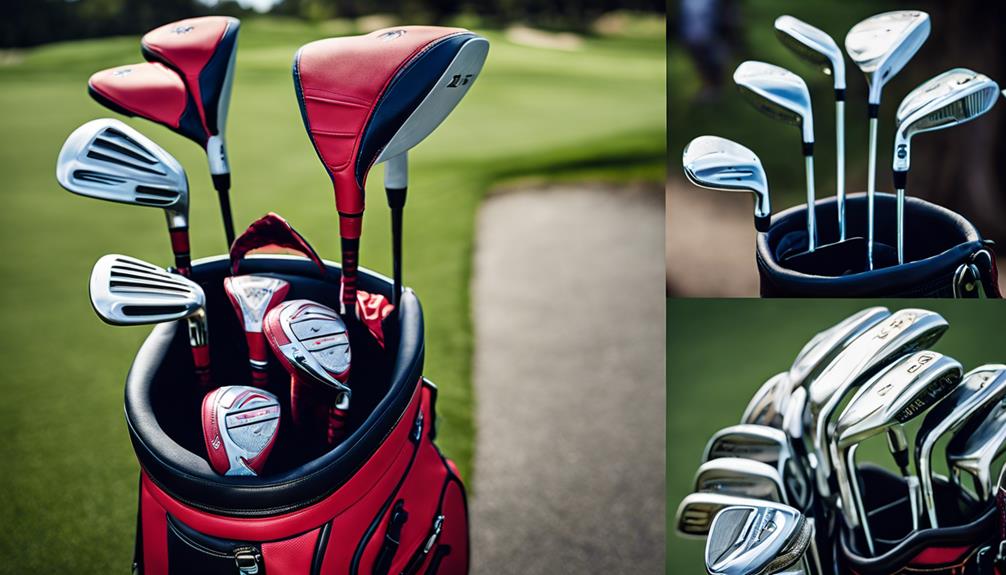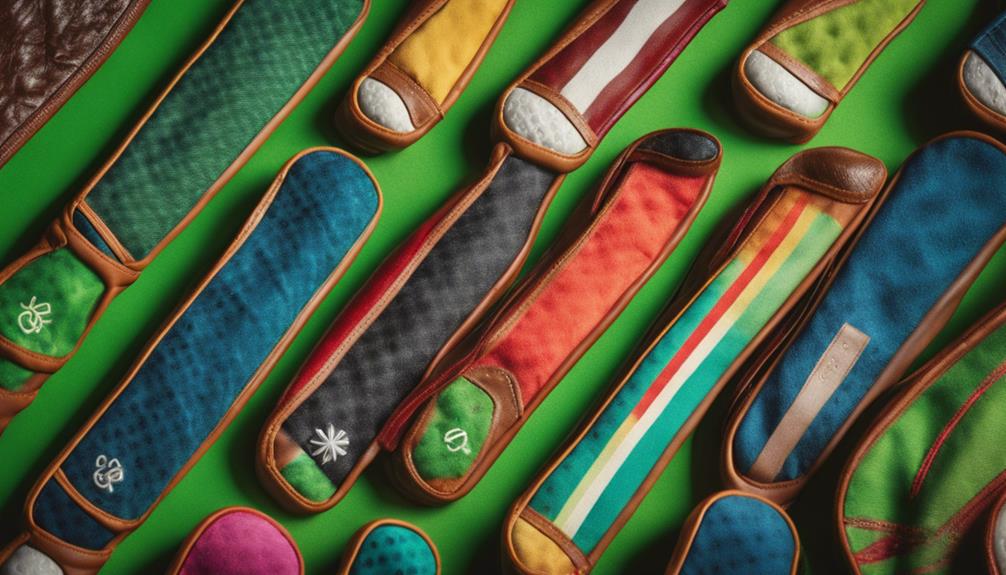- 7 Top Flite Golf Clubs XL for Improved Performance - September 28, 2024
- Top Flite Golf Clubs: Top 5 Reasons to Choose Them - September 28, 2024
- Top 3 Golf Club Fitters for a Perfect Swing - September 28, 2024
You've invested in a set of high-quality golf clubs, and now it's crucial to protect them with the right covers to preserve their performance and extend their lifespan. Golf club covers are designed to shield your clubs from scratches and damage during transport, available in various materials like leather, synthetic, and knit. They're also customizable, allowing you to express your personal style on the course. With different types of covers for drivers, fairway woods, hybrids, and putters, you can choose the perfect fit for your clubs. By understanding the benefits and options, you'll be able to access the full potential of your golf equipment.
Key Takeaways
- Golf club covers are essential for preserving club quality and performance by protecting them from scratches and damage during transport.
- Various materials are available, including leather, synthetic, and knit, each with its own benefits and maintenance requirements.
- Club covers provide essential protection for valuable golf clubs, enhance personal style, and organize golf bags to prevent clutter and damage.
- Different types of covers are designed for specific club protection needs, including driver, fairway wood, hybrid, and putter covers.
Understanding Golf Club Covers
As you explore the world of golf, understanding the significance of golf club covers becomes essential, as they play a critical role in preserving the quality and performance of your clubs. Golf head covers are specifically designed to protect your clubs from scratches and damage during transportation and storage, guaranteeing their longevity and performance.
You can choose from a variety of materials, including leather for durability, synthetic options for easy cleaning, and knit for a vintage appeal. This allows you to select the perfect material that suits your preferences and style.
When it comes to golf head covers, you'll find that customizable head covers provide an opportunity to express your individuality and style on the course. You can opt for unique designs and personalization, making your clubs stand out in your golf bag.
Benefits of Protection and Style
As you consider investing in golf club covers, you'll want to explore the benefits of protection and style.
By using headcovers, you'll not only protect your valuable clubs from damage, but also make a statement on the course with your personal style.
From essential protection to enhanced aesthetics and organized golf bags, the advantages of headcovers are multifaceted and worth exploring.
Club Protection Essentials
Your golf clubs are a significant investment, and protecting them from scratches, dings, and moisture is essential to extending their lifespan and maintaining their performance.
When it comes to club protection, you'll want to focus on the most vulnerable areas, such as the club heads and graphite shafts. Here are some essential protection tips to keep in mind:
- Protect the heads: Use club head covers to shield your woods and putters from damage during transportation and storage.
- Length matters: Opt for longer neck covers to provide extra protection for graphite shafts, which are more prone to damage than steel shafts.
- Customize for convenience: Choose head covers with customization options to express your individuality and aid in club identification and organization within your golf bag.
Club Style Enhancers
By shielding your clubs from damage and maintaining their appearance, golf club covers also become an extension of your personal style, allowing you to express your individuality on the course. With a wide range of designs and materials available, you can personalize your equipment to reflect your unique personality and style.
| Club Style Enhancers | Benefits | Description |
|---|---|---|
| Unique Designs | Express Individuality | Showcase your style with custom designs and colors |
| Noise Reduction | Quieter Transport | Minimize club clanging with soft, protective materials |
| Quick Identification | Enhanced Organization | Identify your clubs quickly with distinct colors and patterns |
Golf Bag Organizers
With golf bag organizers equipped with head covers, you can safeguard your clubs from damage and dirt while also showcasing your personal style, thereby elevating the overall aesthetic of your golf bag. This is especially important for golfers who take pride in their equipment and want to maintain its quality.
Here are some benefits of using head covers in your golf bag organizer:
- Protection from damage: Head covers available in various designs and materials protect your clubs from scratches, dings, and impact damage, preserving their value and longevity.
- Easy club identification: Utilizing head covers allows you to quickly identify your clubs through color and design variations, effectively enhancing organization within the golf bag.
- Reduced noise and risk: The presence of head covers reduces noise from clanging clubs during transport, contributing to a more enjoyable golfing experience and minimizing the risk of damage.
Choosing the Right Headcover

When it comes to selecting the perfect headcover, you'll want to prioritize the types of clubs you use most frequently, as this will dictate the level of protection you need. If you're an avid golfer, you'll likely want to choose to use covers for drivers, fairway woods, and hybrids, as these clubs are more prone to damage. Make sure to take into account the materials you prefer, as leather offers durability and a classic look, while synthetic options like neoprene are easier to clean and often more affordable.
| Club Type | Material | Design |
|---|---|---|
| Driver | Leather or Neoprene | Traditional or Custom |
| Fairway Woods | Synthetic | Bright Patterns or Solid Colors |
| Hybrids | Leather or Neoprene | Classic or Modern Designs |
When selecting a headcover, verify the size matches your club for a snug fit. Ill-fitting covers may fall off or not provide adequate protection. Finally, take your budget into account, as prices can vary greatly based on material and design. By reflecting on these factors, you'll find the perfect headcover to protect your investment and enhance your golfing experience.
Types of Golf Club Covers
You'll find that golf club covers come in a variety of types, each designed to protect a specific club in your bag, from drivers and fairway woods to hybrids, putters, and irons. When it comes to choosing the right cover, it's crucial to take into account the type of club you're protecting.
Here are the main types of golf club covers you'll encounter:
- Driver Covers: Designed to fit the largest and most expensive club in your bag, these covers guarantee your driver head remains scratch-free and dent-free.
- Fairway Wood Covers: Slightly smaller than driver covers, these cater to various wood types, including 3, 5, 7, and 9 woods, providing crucial protection for valuable clubs.
- Hybrid Covers: These covers fit between fairway woods and irons, often featuring a traditional two-piece design with elastic grip for easy use.
Material and Design Options

Golf club covers boast an array of material and design options, allowing you to choose the perfect blend of style, functionality, and protection for your valuable clubs. You can opt for durable leather, which offers a classic appearance but requires regular maintenance to prevent damage. Alternatively, synthetic materials like neoprene and nylon are popular for their affordability, ease of cleaning, and resistance to moisture and wear.
Here's a breakdown of the material options:
| Material | Characteristics |
|---|---|
| Durable Leather | Classic appearance, requires maintenance |
| Synthetic Materials | Affordable, easy to clean, resistant to moisture and wear |
| Knit Covers | Vintage aesthetic, high protection, less durable |
| Customization Options | Select designs, colors, and personalized initials |
| Size and Fit | Secure fit, maximum protection during transport |
With customization options, you can select from a range of designs, colors, and even personalized initials, enhancing your individuality on the course. Remember, the size and fit of head covers are essential, as they should securely accommodate club heads to guarantee maximum protection during transport. By choosing the right material and design, you'll be able to protect your clubs while showcasing your personal style.
Caring for Your Club Covers
As you begin to care for your club covers, it's crucial to understand the specific cleaning and maintenance requirements for your particular covers, taking into account the material they're made of.
You'll need to reflect on whether you have leather, synthetic, or knit covers, as each demands a unique approach to cleaning and conditioning.
Cleaning and Maintenance
Regularly, it's essential to clean your golf head covers to prevent dirt and grime from accumulating and potentially damaging your clubs. You need to cover your clubs with clean covers to maintain their performance and extend the lifespan of your covers.
When it comes to cleaning, different materials require different approaches. Here's what you need to do:
- Leather covers: Use a damp cloth and leather conditioner to keep them clean and supple.
- Synthetic head covers: Wipe them down with a damp cloth to remove dirt and grime – they're easy to clean!
- Knit head covers: Hand wash them with mild soap and warm water to maintain their protective qualities and appearance.
Remember to dry your head covers thoroughly after washing to prevent mildew and maintain their shape. By following these simple cleaning and maintenance tips, you'll be able to enjoy your golf game with confidence, knowing your clubs are well-protected.
Material Selection Matters
When selecting golf club covers, you'll want to contemplate the materials used, since they greatly impact the level of protection, durability, and overall maintenance requirements of your covers. Material selection matters, as it directly affects how well your head covers protect your clubs from damage.
Here's a breakdown of popular materials and their characteristics:
| Material | Maintenance | Durability | Aesthetic |
|---|---|---|---|
| Leather | Regular cleaning and conditioning | High | Classic |
| Neoprene/Nylon | Easy cleaning, resistant to moisture | High | Modern |
| Knit | Hand wash with mild soap and warm water | High | Vintage |
| Custom | Varies depending on material | High | Personalized |
| Standard | Varies depending on material | Medium | Traditional |
Choosing head covers made from durable materials can greatly extend their lifespan and guarantee they effectively protect your clubs from damage. By considering the material selection, you can find the perfect balance of protection, durability, and style for your golf bag.
Storage and Organization
You'll want to guarantee your golf club covers remain in top condition by storing them properly, cleaning them regularly, and organizing them efficiently, which will ultimately extend their lifespan and optimize their performance.
To achieve this, follow these essential storage and organization tips:
- Store in a dry, cool place to prevent mold and deterioration, especially for leather materials that require specific care.
- Organize by club type (drivers, fairway woods, hybrids, putters) to streamline the process of finding the right club during play, enhancing efficiency on the course.
- Clean regularly with a damp cloth to maintain appearance and functionality, especially for synthetic and knit options.
Frequently Asked Questions
Why Do People Put Covers on Their Clubs?
You put covers on your clubs to reap protection benefits, showcasing personal style with various options, and choosing materials that suit your needs, while also learning essential maintenance tips to keep your gear in top condition.
How Many Golf Head Covers Do You Need?
You're wondering how many golf head covers you need, but first, consider the types of covers you want – driver, fairway, hybrid, or putter – and the material choices, custom designs that fit your style, before deciding on the ideal number.
How Do You Read Golf Clubs?
You read golf clubs by identifying club types, such as drivers or irons, noting shaft length and grip size, and examining club materials, like titanium or graphite, to understand their design and purpose.
Do Clubs Come With Covers?
As you unwrap your new driver, you're likely to find a snug, premium club cover waiting to shield it from scratches and dings. Yes, many clubs come with covers, often made of durable materials like leather or neoprene.
Conclusion
You've finally invested in the perfect golf club covers, and now you can relax, knowing your clubs are protected from damage.
But, let's be real, the real challenge begins – keeping those covers from getting lost, worn out, or mismatched.
It's ironic that something designed to protect your clubs can become a hassle in itself.
But with the right knowledge and care, you can guarantee your covers remain a valuable asset, not a frustrating afterthought.




